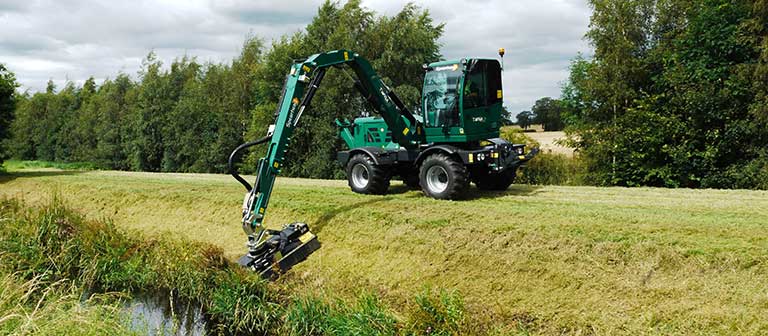Drainage boards prepare for mowing after damp spring

At this time of year, internal drainage boards (IDBs) are preparing to commence their essential annual maintenance programmes to mow and repair watercourses and flood embankments across England’s lowlands.
After a wet first half to the year, forecasts remain variable with a typically British mixture of hot, cold, wet and dry periods as we run into summer. Water management in most lowland parts of England is now a careful balance between draining a surplus of water to retaining and supplying water. Due to the high precipitation and low evaporation up to the end of June, the groundwater is relatively high in a number of areas for the time of year, often at a level that is more typical in the spring.
The wet winter and spring makes the starting position favourable for water management in drier weather as the soil still contains a lot of water. However, winter flooding has left a legacy of bankslips, as well as damage to pumps and other water control assets yet to be repaired, especially across eastern lowland England. A relatively warm and damp spring has also provided strong growing conditions for water and bankside vegetation, which can inhibit capacity and flow within lowland pumped catchments.
Mowing is important. Internal drainage boards mow to prevent ditches and lowland watercourses from closing up, preventing flooding and allowing sufficient water to be supplied in times of drought and also helping to maintain good water quality in ditches and drains. On embankments it is important that the grass cover is strong, helping to protect them from slumping and crest failures. At the same time, ditches and embankments are a habitat for a variety of flora and fauna, and drainage boards want to promote biodiversity. That is why IDBs mow where necessary with care, and leave vegetation where possible.
You can read more about IDBs’ maintenance of lowland watercourses and embankments in this blog.
IDBs’ staff and contractors carry out the work. In certain areas, they will have to drive over private land. They must ensure that the employees can carry out the mowing work properly and safely with the machines. To do this IDBs use a maintenance strip prescribed in their bylaws. This is a protected zone next to a ditch or stream that they use to mow the ditch with a machine, to deposit the cuttings and to inspect the stability of the banks. The width of the maintenance strip depends on the location and is a maximum of nine metres. There may be no obstacles on it that would hinder the maintenance.
Archive
- January 2026
- December 2025
- November 2025
- October 2025
- July 2025
- June 2025
- March 2025
- February 2025
- January 2025
- December 2024
- November 2024
- October 2024
- September 2024
- August 2024
- July 2024
- June 2024
- May 2024
- April 2024
- March 2024
- January 2024
- December 2023
- November 2023
- October 2023
- September 2023
- August 2023
- July 2023
- June 2023
- May 2023
- April 2023
- March 2023
- February 2023
- January 2023
- December 2022
- September 2022
- August 2022
- July 2022
- June 2022
- May 2022
- April 2022
- March 2022
- February 2022
- January 2022
- December 2021
- November 2021
- September 2021
- July 2021
- May 2021
- March 2021
- February 2021
- January 2021
- December 2020
- November 2020
- October 2020
- September 2020
- August 2020
- July 2020
- May 2020
- April 2020
- March 2020
- February 2020
- January 2020
- December 2019
- November 2019
- October 2019
- September 2019
- August 2019
- July 2019
- June 2019
- May 2019
- April 2019
- March 2019
- February 2019
- January 2019
- December 2018
- November 2018
- October 2018
- September 2018
- August 2018
- July 2018
- June 2018
- May 2018
- April 2018
- March 2018
- February 2018
- January 2018
- December 2017
- November 2017
- October 2017
- September 2017
- August 2017
- July 2017
- June 2017
- May 2017
- April 2017
- March 2017
- February 2017
- January 2017
- October 2016
- September 2016
- August 2016
- July 2016
- June 2016
- May 2016
- April 2016
- March 2016
- January 2016
